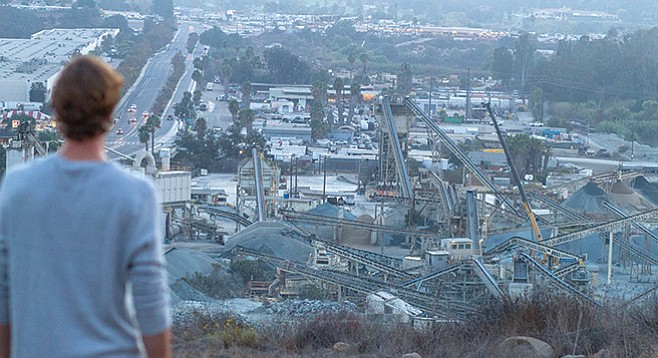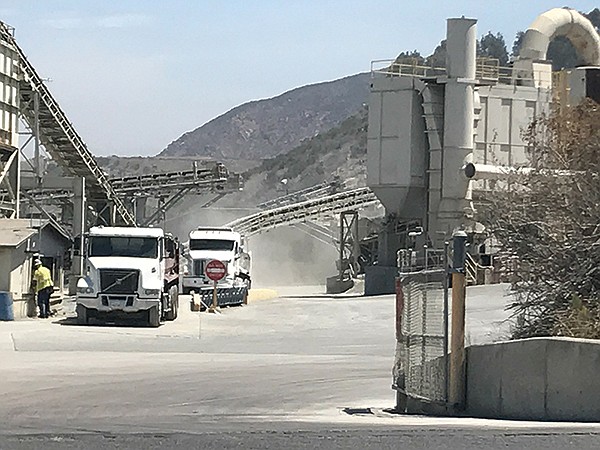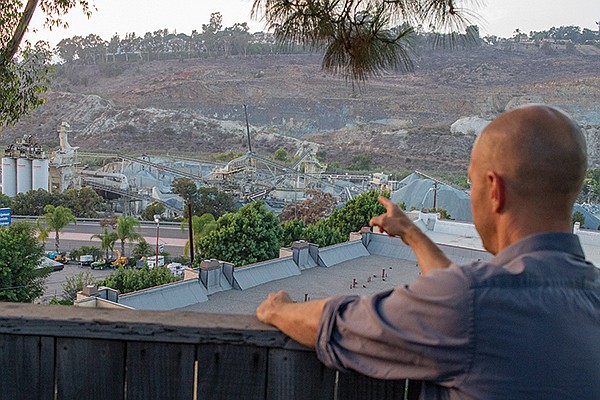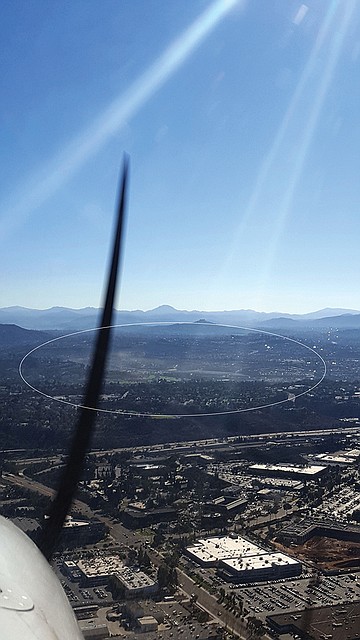 Facebook
Facebook
 X
X
 Instagram
Instagram
 TikTok
TikTok
 Youtube
Youtube

It might seem that Kirk Riley set a trap for investigators at the San Diego County Air Pollution Control District. But it was inadvertent.

Riley, who is 45 and a resident of Del Cerro, had been pressing the investigators to check out his claims, and those of his neighbors, that Superior Ready Mix is causing the dust that permeates the air they breathe and falls on their streets, houses and cars. Superior is the concrete and asphalt manufacturing company located in Allied Gardens on Mission Gorge Road, where Princess View Drive joins it from the south.

Residents who live in Riley’s neighborhood warned that Superior doesn’t usually respond well to complaints. As far back as 2003, the company had to submit to arbitration to work out an agreement with a local resident to ameliorate dust problems. So Riley decided this time first to seek pressure on the company from the Air Pollution Control District.

Riley came to San Diego from western Maryland 17 years ago. “I just thought then that San Diego was a dusty town,” he tells me. “So I never thought much about it. As time went on, I came to realize that the dust was coming from the Superior Ready Mix plant.”
But it wasn’t until Riley saw aerial photographs of dust clouds emanating from Superior and covering his and surrounding neighborhoods that a fire lit under him. His friend Kyle Freed, a former flight instructor, had taken the photos over the course of October 2017. The past summer, he showed them to Riley.
“The photos shocked me,” says Riley. “I thought it can’t be healthy to breathe that stuff in.” A one-page document from 2014, called Superior Ready Mix Source Emissions, provided to Riley by the air control district, confirmed his suspicions. It listed 34 “toxic air contaminants” that the San Diego Superior plant regularly emits. Among them are 4258 pounds per year of crystalline silica.
According to the Occupational Safety and HealthAdministration of the U.S. Department of Labor, “Crystalline silica has been classified as a human lung carcinogen. Additionally, breathing crystalline silica dust can cause silicosis, the formation of scar tissue, thus reducing the lungs’ ability to take in oxygen.”
Combined with Riley’s learning of a non-smoker in his neighborhood who had been diagnosed with chronic obstructive pulmonary disease, the information radicalized him. He went on NextDoor.com and shared what he was beginning to learn. As a result, a number of people reported that, for the first time, they filed a complaint with the Air Pollution Control District. After filing a public records request to the district, Riley received an email containing the contents of, to date, 30 such complaints. The email, he tells me, legally requires that he not share the complaints with others, but notes that they cite health issues and dust everywhere in neighborhoods, including inside of people’s homes.
At first, both Riley and Freed contacted the air control district for help. “As a pilot,” Freed tells me, “I’m very sensitive to the need for staying current on maintenance records. So I asked the district to look into Superior’s records of maintaining the pollution control equipment. They did and cited the company for being behind.
“But Riley went much further than I did,” says Freed, whose townhouse overlooks the Superior rock quarry. But the two did pursue the fate of a broken pump that supplied water to tamp down dust from trucks driving in and out of the plant. In late July, they convinced Vince Landi, an air control district investigator, to look into the situation.
On July 27, Landi emailed Riley the following: “There is no specific timeline to installing the piece of the pump they need to replace. During my inspection, I did not observe dust emitting from the concrete batch plant so I was unable to enforce any District Rule regarding visible emissions. Superior Ready Mix was in compliance with all of the visible emissions aspect of their permitted operations during my investigation yesterday.”
By then, Riley was taking his own photograph of activity at Superior Ready Mix during production hours. He tells me of “a photograph I sent [the air control district] of a dump truck driving through their plant kicking up dust that is thicker than the legally allowed 20 percent opacity.”
In response, Jorge Lopez, a district supervisor, wrote: “Visible emissions are not allowed to exceed ... 20 percent opacity (for dust) for more than 3 minutes in any period of 60 consecutive minutes….
“The requirements ... are not enforced on an instantaneous basis.”
Riley then attempted, on August 8, to apply the 20 percent rule to his photo of an opaque plume rising from the asphalt producing tower. Vince Landi responded, saying he went out and viewed the tower from across the street. “Superior did not appear to be operating when I arrived,” he wrote.
“They know that the plant stops producing materials that late in the day,” Riley tells me, “yet they show up anyway so they can get their clear blue sky photos of ‘proof’ that the plant is not polluting.”
After sending the district more pictures and a subsequent conversation with Landi by phone, Riley concluded that the inspector’s visits to Superior were cursory and superficial and he began to feel that the air control district was stonewalling.
It took Landi until August 14 to email back a fuller explanation. What Riley had seen was steam. “Hot Mix Asphalt batch plants,” Landi explained, “employ oil heaters and drum dryers in their operations. Because of the hot materials in the process, steam plumes are formed by the combustion of fuels or water vapor from the dryers. With lower temperatures and higher humidity at night, the steam plumes are more visible.
“The temperature of the finished product is generally between 100 and 200 degrees Celsius (212 and 392 degrees Fahrenheit), which can also generate steam as it is loaded unto the trucks.”
The following day, Jorge Lopez, Landi’s supervisor, corroborated his view, but acknowledged that in the plumes, consisting “primarily” of blue smoke and steam, “some particulate matter may be present.” Lopez added that “particulate matter emissions could result from the aggregate storage piles or from access and haul roads.”
The upshot was that the air control district did not plan to take any action to encourage Superior Ready Mix to help reduce the dust pollution.
But Riley was sure that the thick opacity of the plumes he had seen coming out of the asphalt tower indicated that they contained much more than steam and that he had located one of the most crucial sources of the dust that was falling on the surrounding neighborhoods.
Meanwhile, out of his dissatisfaction with the responses of the air control district, Riley finally decided to call Superior, where he was put in touch with the company’s attorney, Arnie Veldkamp. “I couldn’t believe how much I then learned,” Riley tells me. Veldcamp said “he was aware of the dust problems and that it was his company’s fault. He said they just found out about some faulty/broken dust suppression equipment in the baghouse [think of a big metal box filled with hundreds of vertical bags that collect dust the way vacuum cleaner bags do].” There was “an issue with the heat exchanger and that it was all being replaced….”
On August 13, Veldkamp followed up with an email to Riley. “I understand that the heat exchanger and the baghouse have been repaired, and so the dust from the asphalt plant operation should be negligible. We are operating.
“We sweep the streets three times a day, at 4:00 am, mid-day and then mid-afternoon. We paved the interior street that is the extension of Princess View several months ago, and have installed a truck wash to remove the dirt from truck tires before they exit the quarry at the main entrance/exit.”
In a follow-up phone call to Riley on August 16, he tells me, Veldkamp said that “the leak in the heat exchanger that keeps the asphalt hot had been repaired and that the asphalt tower is only running at 50 percent till the damaged bags in the bag house can be repaired.”
Of course, Riley wanted Jorge Lopez at the air control district to know. On August 19, he wrote: “So Mr. Lopez... I find the information that was provided to me by Superior Ready Mix to be a bit conflicting to the … reassurance from the [Air Pollution Control District] that everything was functioning properly over at Superior Ready Mix…. It would be really nice if the residents around here could look to the [Air Pollution Control District] as allies in our fight for clean air instead of the other way around.”
Jessica Northrup, of the San Diego County Land Use and Environment Group, submitted a late comment: “This past August, the Air Pollution Control District issued a Notice of Violation to Superior Ready Mix for failing to properly maintain the control equipment (bag house). Subsequent inspections have shown the bag house free of visible emissions indicating the damaged bags were replaced.


It might seem that Kirk Riley set a trap for investigators at the San Diego County Air Pollution Control District. But it was inadvertent.

Riley, who is 45 and a resident of Del Cerro, had been pressing the investigators to check out his claims, and those of his neighbors, that Superior Ready Mix is causing the dust that permeates the air they breathe and falls on their streets, houses and cars. Superior is the concrete and asphalt manufacturing company located in Allied Gardens on Mission Gorge Road, where Princess View Drive joins it from the south.

Residents who live in Riley’s neighborhood warned that Superior doesn’t usually respond well to complaints. As far back as 2003, the company had to submit to arbitration to work out an agreement with a local resident to ameliorate dust problems. So Riley decided this time first to seek pressure on the company from the Air Pollution Control District.

Riley came to San Diego from western Maryland 17 years ago. “I just thought then that San Diego was a dusty town,” he tells me. “So I never thought much about it. As time went on, I came to realize that the dust was coming from the Superior Ready Mix plant.”
But it wasn’t until Riley saw aerial photographs of dust clouds emanating from Superior and covering his and surrounding neighborhoods that a fire lit under him. His friend Kyle Freed, a former flight instructor, had taken the photos over the course of October 2017. The past summer, he showed them to Riley.
“The photos shocked me,” says Riley. “I thought it can’t be healthy to breathe that stuff in.” A one-page document from 2014, called Superior Ready Mix Source Emissions, provided to Riley by the air control district, confirmed his suspicions. It listed 34 “toxic air contaminants” that the San Diego Superior plant regularly emits. Among them are 4258 pounds per year of crystalline silica.
According to the Occupational Safety and HealthAdministration of the U.S. Department of Labor, “Crystalline silica has been classified as a human lung carcinogen. Additionally, breathing crystalline silica dust can cause silicosis, the formation of scar tissue, thus reducing the lungs’ ability to take in oxygen.”
Combined with Riley’s learning of a non-smoker in his neighborhood who had been diagnosed with chronic obstructive pulmonary disease, the information radicalized him. He went on NextDoor.com and shared what he was beginning to learn. As a result, a number of people reported that, for the first time, they filed a complaint with the Air Pollution Control District. After filing a public records request to the district, Riley received an email containing the contents of, to date, 30 such complaints. The email, he tells me, legally requires that he not share the complaints with others, but notes that they cite health issues and dust everywhere in neighborhoods, including inside of people’s homes.
At first, both Riley and Freed contacted the air control district for help. “As a pilot,” Freed tells me, “I’m very sensitive to the need for staying current on maintenance records. So I asked the district to look into Superior’s records of maintaining the pollution control equipment. They did and cited the company for being behind.
“But Riley went much further than I did,” says Freed, whose townhouse overlooks the Superior rock quarry. But the two did pursue the fate of a broken pump that supplied water to tamp down dust from trucks driving in and out of the plant. In late July, they convinced Vince Landi, an air control district investigator, to look into the situation.
On July 27, Landi emailed Riley the following: “There is no specific timeline to installing the piece of the pump they need to replace. During my inspection, I did not observe dust emitting from the concrete batch plant so I was unable to enforce any District Rule regarding visible emissions. Superior Ready Mix was in compliance with all of the visible emissions aspect of their permitted operations during my investigation yesterday.”
By then, Riley was taking his own photograph of activity at Superior Ready Mix during production hours. He tells me of “a photograph I sent [the air control district] of a dump truck driving through their plant kicking up dust that is thicker than the legally allowed 20 percent opacity.”
In response, Jorge Lopez, a district supervisor, wrote: “Visible emissions are not allowed to exceed ... 20 percent opacity (for dust) for more than 3 minutes in any period of 60 consecutive minutes….
“The requirements ... are not enforced on an instantaneous basis.”
Riley then attempted, on August 8, to apply the 20 percent rule to his photo of an opaque plume rising from the asphalt producing tower. Vince Landi responded, saying he went out and viewed the tower from across the street. “Superior did not appear to be operating when I arrived,” he wrote.
“They know that the plant stops producing materials that late in the day,” Riley tells me, “yet they show up anyway so they can get their clear blue sky photos of ‘proof’ that the plant is not polluting.”
After sending the district more pictures and a subsequent conversation with Landi by phone, Riley concluded that the inspector’s visits to Superior were cursory and superficial and he began to feel that the air control district was stonewalling.
It took Landi until August 14 to email back a fuller explanation. What Riley had seen was steam. “Hot Mix Asphalt batch plants,” Landi explained, “employ oil heaters and drum dryers in their operations. Because of the hot materials in the process, steam plumes are formed by the combustion of fuels or water vapor from the dryers. With lower temperatures and higher humidity at night, the steam plumes are more visible.
“The temperature of the finished product is generally between 100 and 200 degrees Celsius (212 and 392 degrees Fahrenheit), which can also generate steam as it is loaded unto the trucks.”
The following day, Jorge Lopez, Landi’s supervisor, corroborated his view, but acknowledged that in the plumes, consisting “primarily” of blue smoke and steam, “some particulate matter may be present.” Lopez added that “particulate matter emissions could result from the aggregate storage piles or from access and haul roads.”
The upshot was that the air control district did not plan to take any action to encourage Superior Ready Mix to help reduce the dust pollution.
But Riley was sure that the thick opacity of the plumes he had seen coming out of the asphalt tower indicated that they contained much more than steam and that he had located one of the most crucial sources of the dust that was falling on the surrounding neighborhoods.
Meanwhile, out of his dissatisfaction with the responses of the air control district, Riley finally decided to call Superior, where he was put in touch with the company’s attorney, Arnie Veldkamp. “I couldn’t believe how much I then learned,” Riley tells me. Veldcamp said “he was aware of the dust problems and that it was his company’s fault. He said they just found out about some faulty/broken dust suppression equipment in the baghouse [think of a big metal box filled with hundreds of vertical bags that collect dust the way vacuum cleaner bags do].” There was “an issue with the heat exchanger and that it was all being replaced….”
On August 13, Veldkamp followed up with an email to Riley. “I understand that the heat exchanger and the baghouse have been repaired, and so the dust from the asphalt plant operation should be negligible. We are operating.
“We sweep the streets three times a day, at 4:00 am, mid-day and then mid-afternoon. We paved the interior street that is the extension of Princess View several months ago, and have installed a truck wash to remove the dirt from truck tires before they exit the quarry at the main entrance/exit.”
In a follow-up phone call to Riley on August 16, he tells me, Veldkamp said that “the leak in the heat exchanger that keeps the asphalt hot had been repaired and that the asphalt tower is only running at 50 percent till the damaged bags in the bag house can be repaired.”
Of course, Riley wanted Jorge Lopez at the air control district to know. On August 19, he wrote: “So Mr. Lopez... I find the information that was provided to me by Superior Ready Mix to be a bit conflicting to the … reassurance from the [Air Pollution Control District] that everything was functioning properly over at Superior Ready Mix…. It would be really nice if the residents around here could look to the [Air Pollution Control District] as allies in our fight for clean air instead of the other way around.”
Jessica Northrup, of the San Diego County Land Use and Environment Group, submitted a late comment: “This past August, the Air Pollution Control District issued a Notice of Violation to Superior Ready Mix for failing to properly maintain the control equipment (bag house). Subsequent inspections have shown the bag house free of visible emissions indicating the damaged bags were replaced.
Comments